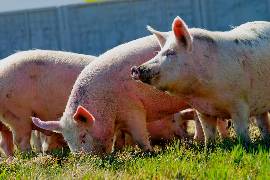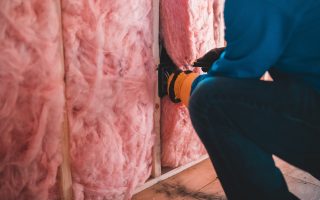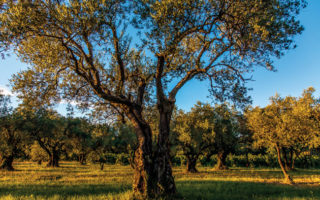Looking after Pigs
Advice


Pigs are without doubt one of my favourite animals to keep – time and time again they have proven themselves to be the ultimate in smallholder livestock. Why?
The Upside
Pigs eat anything – this means that on your smallholding you never have to waste a single scrap of organic matter again. Pigs can take your kitchen and garden waste and turn it into garden fertiliser quicker and more efficiently than any compost bin/heap you care to mention.
Pigs can plough any type of land, even land a tractor cannot manage to plough; and fertilise it as it goes. It will also gain sustenance from its work as it eats almost anything green on the land.
All this and, unlike a tractor, it does not damage the atmosphere as it works, and when it has finished its work for you it will taste better for all the work and nourishment it has gained – again, unlike a tractor!
Seriously though, pigs are a delight to keep. They are wonderfully entertaining, extremely productive and hard working. Reclamation of seemingly unproductive land is possible using pig power.
The Downside
If you are going to keep your pigs outside – which is the way I do it – you will need a fair bit of land, and secure enclosures which means some initial financial investment.
I have successfully used just electric fencing for the last two and a half years. Previously I have used sheep netting and barbed wire with less success. It did contain our pigs for two years but by the time we had another batch of weaners were useless as the pigs had undermined the fence posts.
You will also have to give your pigs a house to protect them from the rain, wind and cold.
Pigs like to dig and if you do not have enough land to rotate them on then you run the risk of your land becoming ‘Pig Sick’. This means it will be an over-used mass of sticky mud that smells and feels awful. This in turn will lead to your pigs becoming sick ‘as Sick as a Pig’ and this can mean dead animals within days; or at least a large bill from the vet, and meat contaminated with drugs.
How to Get Started
Keeping pigs is a responsibility and it deserves consideration before you take the plunge. Before you buy, find a seller who will let you visit their holding. This way you can make sure you are comfortable being in contact with pigs, touching them and perhaps even feeding them. Pigs can be large and aggressive – if you have problems being with a tame one that a smallholder will let you touch, imagine how difficult it would be for you to own one.
Most smallholders should consider buying a couple of weaners (young piglets about 8 to 12 weeks old, weaned off their mothers milk,). I suggest buying two because pigs are socially gregarious creatures and crave company.
They are relatively inexpensive to buy – at the time of writing they are about 75€ for a 12 week old 30Kg piglet at markets in France, but try to get them from another smallholder in your area.
I advise this for two reasons: one they don’t have to travel too far to your home, avoiding stress; two, they are more likely to be acclimatised to the weather conditions in your area.
Older breeds will live outside the whole year round without any problems while crosses of older breeds will also fair well outside. However, commercial hybrids will not cope outside – at all.
Commercial pigs are bred for a purpose – to produce high quantities of meat in short periods of time, and this has come at a cost. Commercial breeds tend to be pink and hairless making them generally unsuitable for outside living. They can burn in hot sun and freeze to death in cold spells.
Although they produce high quantities of meat it is not always the best quality meat. Older more traditional breeds have historically won most taste tests in comparison to hybrids.
Feeding
Feed pigs on any excess garden produce and kitchen and garden waste, and top these up with a high protein feed such as milled barley. However, it is very important to give them a good balanced diet so if you do not have excesses of garden produce and kitchen waste you will have to supplement their feed.
Many of the preparatory feeds for pigs are very good, but not devoid of additives. Medication in the form of antibiotics and growth promoters are fed to pigs as a matter of course in factory farm settings; so choose your preparatory feed carefully.
A good supply of fresh water should always be available to pigs of all ages – failure to supply this will have detrimental effects on both their ability to assimilate their food as well as their general health.
Weight gain and water are emphatically linked. If you feed them more than they need and fail to give them an adequate water supply they will grow slower. Adding water to pigs feed can also be beneficial helping them more effectively assimilate the nutrients in their feed.
Two additions to your pigs feed will help you save on vet bills – garlic and molasses. The latter helps deter worms from infesting your pigs; and garlic is a natural antiviral.
Housing Needs
Pigs need housing that is draft free at the floor level and dry. This can be achieved with a pig ark purchased from a good supplier or from straw bales staked to the ground with hazel and covered with tin sheets. The latter, however, will be pulled apart before the pigs get to a good weight. Pigs are strong and gregarious animals that like to explore every bit of their environment.
Pigs housing should be durable and lacking in sharp edges that could cut the them; it should keep out drafts and the rain, and be ventilated, espcailly at the top so in hot weather your pigs will not make the house wet from perspiration. It should also be large enough for one of the pigs to stand and turn without walking on any of the other pigs in the house.
It is possible to meet these needs without a large expenditure but whatever you provide has to be durable – a pig can reach 200Kg in weight in less than a year. A mature sow will weigh around 300Kg or more and be strong enough to move her own weight with her nose, so a lightweight structure will be pulled apart quicker than it was put together.
Wood is a good material for pig ark construction but it must be built well and safely. Your housing should take into account how many pigs you will be keeping and the largest weight they will attain before slaughter.
Open Ground
Two pigs that will go to slaughter at 100Kg will need a house that’s around 2 meters square, plus some space outside which is a minimum of 20 meters square, but preferable about half an acre. You can expect two pigs to decimate this area in the five to six months it will take to reach a good weight for slaughter.
The area should then be seeded and left to recover without any further stock on it. Ideally you should not use this area for more than two years without a one-year rest before pigs are returned to the site again.
Pigs need a plentiful supply of bedding material. Straw is excellent for this, but barley straw is even better as they will eat it, providing a great source of food and trace elements. Just make sure you replenish it regularly.
More Water
I know I already mentioned water, but I have not mentioned a pigs real passion in life, wallowing. There is an old saying, which has like many an old saying has been distorted in modern language. The original goes like this ‘as happy as a pig in mud’. I will leave you to work out the distortion!
But very seriously pigs like to wallow. It helps them stay cool in hot weather, it also provides a good deal of protection from the sun, and it helps to keep their skin clean and free of parasites.
Don’t underestimate any of these last points – the biggest killer of pigs kept in sheds is pneumonia, either due to cold wet conditions in winter or hot sweaty conditions in summer.
Steve Hanson
Share to: Facebook Twitter LinkedIn Email
More in courses, food, garden, health, markets, summer, travel
By FrenchEntrée
Leave a reply
Your email address will not be published. Required fields are marked *



